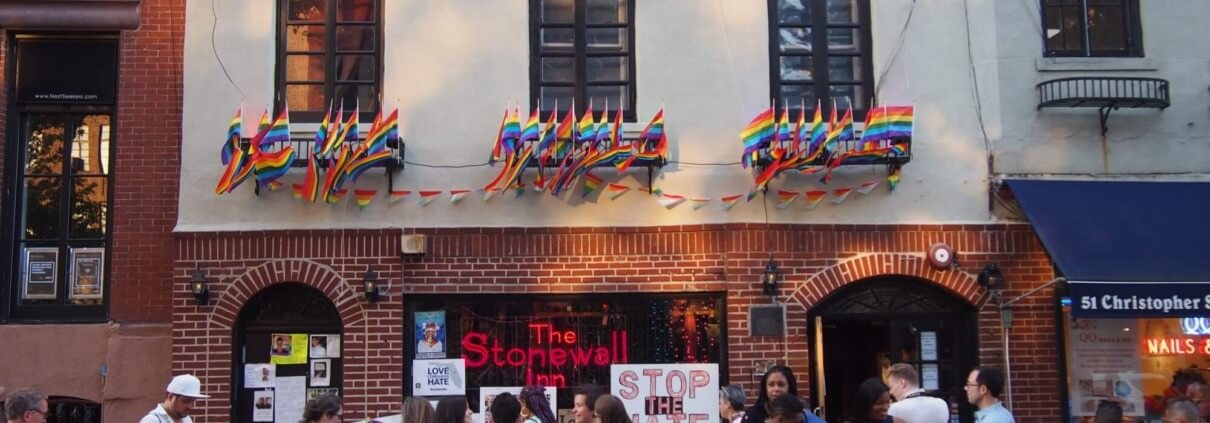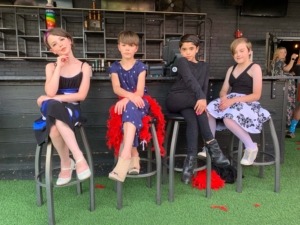50th Anniversary of Stonewall
In 2009, Art from Ashes founded the Running of the Gays event—a faux marathon in heels to fund creative empowerment workshops specifically for queer youth. Every year for 10 years, Art from Ashes has raised money from the LGBTQIA community and advocates through music, live shows featuring drag queens and kings, and spoken word poetry from LGBTQ+ youth and supporters, in order to show both emotional and practical support for the struggling young people in our community.
Because 2019 is the 50-year anniversary of the Stonewall riots, widely considered to be the single most important event leading to the gay liberation movement and the modern fight for LGBT rights in the United States, Art from Ashes Communications Team Lead Abigail Fanara has written the article below that highlights the history of that movement and the inception of the first gay pride parades in the United States and many other countries.
50 Years Ago
In 1969, there were only a few places in the United States where LGBTQIA people could just “be”—the places your parents warned you about and that society condemned. One such place was the Stonewall Inn in Greenwich Village, New York, now a designated U.S. National Historic Landmark and National Monument. At that time, Stonewall was owned by the mob, which took advantage of the liquor laws in New York that discriminated against anyone who was even suspected of being gay. They served watered down alcohol in unsanitary conditions without a liquor license, which was fine as long as they paid off the police. But that dirty, unlicensed dive bar was a sacred place for LGBTQIA people. It was a place where drag queens, gays, lesbians, and “street kids,” (many of whom were sex workers living on the streets, shunned by their families) were free to be themselves.
By 1969 the LGBTQIA movement was still small, but growing, and those who were a part of it were in constant danger of attack or arrest. Being “out” was not an option if you wanted to have a job, housing, or simply not be arrested or admitted to a mental health facility. Homosexuality was criminalized and treated as perversion or psychopathy. Police, particularly the NYPD, often used entrapment and raids as a way to arrest LGBTQIA people for occupying a public space.
1969 was a mayoral election year in New York City, and John Lindsay, up for reelection, pledged to “clean up” the Village that summer. The existing targets on the backs of LGBTQIA residents in the Village grew larger, and safety became more elusive. The raids and police harassment became more and more frequent. On June 28th of that year, for the second time that week, the police raided the Stonewall Inn. What happened during that raid changed the lives of LGBTQIA Americans forever.
Maybe it was the particularly violent treatment of a lesbian woman fighting her arrest, and equally as likely, enough was just enough, but the raid at the Stonewall Inn that night did not go according to plan. A large crowd gathered as the police were demanding I.D.s and loading drag queens into paddy wagons. At first, the crowd talked back and made fun of the police. Then the crowd began to grow, and according to witnesses, a sense of rage began to take over. The rage was about the harassment and violence committed by the police, about the box that society had forced them to live in, and the discrimination they faced every day over who they were born to be. Eventually, that rage turned into action for gay liberation.
Fires were started. Trash cans, bricks, and bottles were thrown at the police who, not expecting any trouble, were so scared they barricaded themselves inside the bar. The crowd outside grew larger and angrier. Finally, buses full of backup police showed up in full riot gear. They started pushing the crowd away from Stonewall, but the crowd would just re-form in an alley or side street and come back right behind the police. This went on for hours.
Protests continued for days and got increasingly more risky and violent, but the LGBTQIA movement had gained momentum, and they were determined to make it count. The Gay Liberation Front was formed. Sylvia Rivera and Marsha “Pay It No Mind” Johnson, two gender nonconforming drag queens and sex workers who were at Stonewall on June 28th formed S.T.A.R (Street Transvestite Action Revolutionaries). S.T.A.R. was a leftist, gender nonconforming organization that served homeless LGBTQIA youth and sex workers by providing housing and other forms of support. The LGBTQIA movement was becoming larger and more organized. One year later, the Christopher Street Liberation Day parade marked the anniversary of the Stonewall Uprising and was the first major LGBTQIA Pride march in the United States.
Those the Movement Left Behind
Though the Stonewall Uprising gave the LGBTQIA movement a giant push into the mainstream, there were groups that were largely left behind. Some feminist lesbians in the movement felt that gender nonconforming drag queens were being misogynistic when they dressed in women’s clothes. Because of this, at the 1973 Gay Pride parade, people like Rivera and Johnson were asked to march at the back of the parade. These were the queens of the Stonewall Uprising, however, so they did not comply. Sylvia Rivera marched on stage and called the movement out for their mistreatment of women of color and the gender nonconforming drag queens who had risked and lost so much for the movement. She spoke of the work that S.T.A.R did with, “your gay brothers and your gay sisters in jail, who write to me every motherfuckin’ week and ask me for your help.” Rivera, nearly out of breath, yelled out her personal sacrifice that led to the existence of that very march: “I have been beaten. I have had my nose broken. I have been thrown in jail. I have lost my job. I have lost my apartment for gay liberation and you all treat me this way?” She ended her speech leading an emotional chant for “gay power.”
Most of the patrons of Stonewall were “street kids,” sex workers, and drag queens, and they often were on the front lines in the daily battle for gay liberation. They were harassed, murdered, beaten, taken to jail at higher rates than anyone else within the movement. In the case of gay rights (and arguably, in many cases in many movements), the ones with the least, gave the most. In 1973, S.T.A.R was dissolved.
In 1999, Johnson’s body was found in the Hudson River under suspicious circumstances. The police deemed it a suicide and closed the case without further investigation, although many of her friends suspected foul play. Some witnesses even told the police they saw her running from someone the evening she died. Horrifically, Johnson’s death is not unlike many within the trans community. For years, trans women (particularly trans women of color) were being murdered with no response from the police, the media, or the mainstream LGBTQIA community.
In 2000, eight days before the anniversary of the Stonewall Uprising, a 25-year-old trans woman of color named Amanda Milan was murdered at a bus terminal in New York City by a man who had been harassing her. She was stabbed in the neck and died at St. Vincent’s hospital that night. Milan’s case garnered attention and outrage from the trans community. Rivera reformed S.T.A.R (Street Trans Action Revolutionaries) in response to Milan’s murder and worked to ensure her case was investigated and called for a broadening of the definition of gender to the New York City Human Rights Law. For the first time, people were paying attention to the murder of a trans woman, yet her murderer was still only sentenced to 17 years in prison.
LGBTQIA Today
While many battles in the fight for gay liberation have been won, there is still so much work to be done. Today, trans women of color are murdered at staggering rates and face more violence than anyone else in the LGBTQIA community. Murders of trans women of color still largely get brushed under the rug, and if there is a conviction, the jail time is like a slap on the wrist. While more youth feel they can openly identify as gay, lesbian, transgender, or queer, rates of violence and harassment are still high. LGBTQIA youth face higher rates of addiction, homelessness, and suicide than their non-LGBTQIA peers.
In spite of the forces against the LGBTQIA community, the movement is growing bigger and getting stronger. Whenever you start to shine brighter, the darkness will try harder to overtake you. But just as the queens of Stonewall fought back and changed the course of the gay rights movement in one significant evening, so can we. Most of the people at the Stonewall Uprising were young, some still in their teens.
50 years ago, on June 28th, 1969, a group of young outcasts changed the country for the better. They are the reason we celebrate Pride every year. They didn’t have much, and at the time, they didn’t even have a unified community, yet they still managed to make a serious impact and put LGBTQIA into the mainstream.
Progress ebbs and flows and there will always be work to be done. So celebrate this month, celebrate the progress that’s been won, the people who won it, and the people who fight still. Celebrate yourself, have pride in who you are and everything that makes you you.
As we all continue the fight for liberation, let’s remember the work and sacrifice that it took. Remember Marsha “Pay It No Mind” Johnson and Sylvia Rivera, remember Matthew Shepard and Amanda Milan and all those who have left us too early, and so tragically. Remember what we all are fighting for, remember to be inclusive. Most importantly, remember that none of us are alone; that there are many of us who stand together—that there are communities like Art from Ashes that exist to hold space for those who don’t believe they belong.





